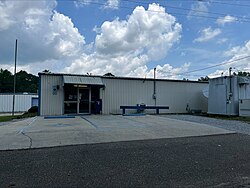Eastabuchie, Mississippi
Eastabuchie, Mississippi | |
|---|---|
 Eastabuchie Post Office | |
| Coordinates: 31°26′08″N 89°17′00″W / 31.43556°N 89.28333°W | |
| Country | United States |
| State | Mississippi |
| County | Jones |
| Area | |
| • Total | 1.90 sq mi (4.91 km2) |
| • Land | 1.89 sq mi (4.89 km2) |
| • Water | 0.01 sq mi (0.02 km2) |
| Elevation | 171 ft (52 m) |
| Population (2020) | |
| • Total | 187 |
| • Density | 99.10/sq mi (38.26/km2) |
| Time zone | UTC-6 (Central (CST)) |
| • Summer (DST) | UTC-5 (CDT) |
| Area code | 601 |
| FIPS code | 28-20740 |
| GNIS feature ID | 669617 |
Eastabuchie is a census-designated place and unincorporated community in southwestern Jones County, Mississippi.[2] It is located along U.S. Route 11, just north of the Forrest County line. the community has a post office with the ZIP code 39436.[3] Eastabuchie is part of the Laurel Micropolitan Statistical Area.
History
[edit]The name Eastabuchie is derived from a native Choctaw language term for the Leaf River.[4]
Eastabuchie is located on the Norfolk Southern Railway and was incorporated on February 19, 1890. It was unincorporated at an unknown date.[5]
It was first named as a CDP in the 2020 Census which listed a population of 187.[6] The small, rural town is home to the studios of television station WDAM, the area's NBC and ABC affiliate.
In 1912, according to Frank Leslie's Weekly, several Confederate veterans lost their lives in a train wreck in Eastabuchie.
Demographics
[edit]| Census | Pop. | Note | %± |
|---|---|---|---|
| 2020 | 187 | — | |
| U.S. Decennial Census[7] 2020[8] | |||
2020 census
[edit]| Race / Ethnicity (NH = Non-Hispanic) | Pop 2020[8] | % 2020 |
|---|---|---|
| White alone (NH) | 106 | 56.68% |
| Black or African American alone (NH) | 70 | 37.43% |
| Native American or Alaska Native alone (NH) | 1 | 0.53% |
| Asian alone (NH) | 0 | 0.00% |
| Pacific Islander alone (NH) | 0 | 0.00% |
| Some Other Race alone (NH) | 0 | 0.00% |
| Mixed Race or Multi-Racial (NH) | 2 | 1.07% |
| Hispanic or Latino (any race) | 8 | 4.28% |
| Total | 187 | 100.00% |
Education
[edit]Public education in the Jones County section of Eastabuchie is provided by the Jones County School District.[9] Campuses serving the community include Moselle Elementary School (Grades K–6) and South Jones High School (Grades 7–12).
In Forrest County portions, it is served by the Petal School District.[10]
Jones County is in the zone of Jones College.[11] Forrest County is in the zone of Pearl River Community College.[12]
Notable people
[edit]- John R. Baylis, chemist and sanitary engineer[13]
- Noah Webster Overstreet, architect
References
[edit]- ^ "2020 U.S. Gazetteer Files". United States Census Bureau. Retrieved July 24, 2022.
- ^ U.S. Geological Survey Geographic Names Information System: Eastabuchie, Mississippi
- ^ USPS – Cities by ZIP Code
- ^ Baca, Keith A. (2007). Native American Place Names in Mississippi. University Press of Mississippi. p. 33. ISBN 978-1-60473-483-6.
- ^ Howe, Tony. "Eastabuchie, Mississippi". Mississippi Rails. Retrieved June 26, 2022.
- ^ "Eastabuchie CDP, Mississippi". United States Census Bureau. Retrieved March 13, 2022.
- ^ "Decennial Census of Population and Housing by Decades". US Census Bureau.
- ^ a b "P2: Hispanic or Latino, and Not Hispanic or Latino by Race – 2020: DEC Redistricting Data (PL 94-171) – Eastabuchie CDP, Mississippi". United States Census Bureau.
- ^ "2020 CENSUS - SCHOOL DISTRICT REFERENCE MAP: Jones County, MS" (PDF). U.S. Census Bureau. Retrieved April 13, 2022.
- ^ "2020 CENSUS - SCHOOL DISTRICT REFERENCE MAP: Forrest County, MS" (PDF). U.S. Census Bureau. Retrieved April 13, 2022.
- ^ "Profile". Jones College. Retrieved September 27, 2024.
- ^ "2014-2016 Catalog" (PDF). Pearl River Community College. Archived from the original (PDF) on August 7, 2015. Retrieved April 13, 2022.
- ^ Lives of Mississippi Authors, 1817-1967. Jackson, Mississippi: University Press of Mississippi. 1981. p. 24.
External links
[edit]- U.S. Geological Survey Geographic Names Information System: Eastabuchie, Mississippi
- "2020 CENSUS - CENSUS BLOCK MAP: Eastabuchie CDP, MS" (PDF). U.S. Census Bureau.


 French
French Deutsch
Deutsch


